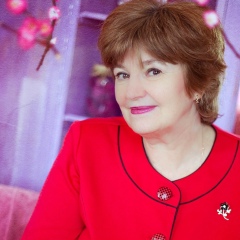Самые сильные эмоции достаются маме
Мне было пять лет. Я ходила с братьями в магазин. Прыгнула со ступеньки и упала коленками на асфальт. Обе коленки были содраны до крови. Мне приложили подорожник и на закорках отнесли к бабушке. Несли по очереди, попутно срывая новые листья подорожника. У бабушки мои раны промыли, полили зеленкой, замотали бинтами. При этом все приговаривали, какая я молодец, какая я большая, даже не заплакала. Я тоже думала, что я молодец. А вечером пришла с работы мама. Мама увидела забинтованные коленки, я увидела маму, и как будто некий транс с меня сошел. Я вдруг начинаю безутешно рыдать у мамы на коленях. Мне стыдно, что я плачу, я не понимаю, откуда взялись потоки слез, но я никак не могу остановиться. Взрослые удивляются. С момента падения уже прошло много часов. Почему я решила зарыдать только сейчас, ведь уже давно не больно? Больно было в момент падения, больно было в момент обработки ран, но тогда я все вытерпела, а сейчас расплакалась. Это были слезы не про боль. Мне не было в тот момент больно. Мне было себя очень жалко. Эту печаль я смогла вылить только на маму. Потому что другие не подходили на роль контейнера для моих эмоций. Для них я старалась быть «молодец» и «уже большая». А с мамой можно быть собой. Кому еще плакать, если не маме? Образно говоря, у мамы самая впитывающая жилетка, много слез может взять на себя.
Детство — это ведь не только радость и любопытство. Печаль, боль, гнев, ярость, ненависть, бессилие, отчаяние — все тоже есть в жизни ребенка. Ему необходима помощь в проживании таких сильных эмоций. Одна из родительских функций — «контейнировать» детские эмоции. Образно говоря, родители должны создать некий контейнер (или жилетку — как вам больше нравится), куда ребенок может выгрузить эмоции, с которыми ему самому сложно справляться. И если у мамы получилось стать таким контейнером для ребенка, то именно ей будет доставаться больше всего негативных эмоций. Со стороны может казаться, что мама не умеет поладить с ребенком: «Без мамы золотой ребенок. Только мама придет, сразу истерики начинаются», «Без тебя он себя гораздо лучше ведет», «Как подменили ребенка! Такой хороший весь день был, пока мама не пришла». Это значит, мама умеет сформировать пространство для безопасной демонстрации любых эмоций. Можно плакать, можно кричать, не боясь, что тебя начнут стыдить или ругать.
Важно только не путать способность «контейнировать» эмоции с неспособностью мамы держать рамки. Потому что внешне они могут выглядеть одинаково: мама пришла, и ребенок стал капризничать.
Но в первом случае ребенок выгружает маме накопленные за день эмоции, а во втором он слезами добивается того, чего невозможно было получить от других взрослых, зная, что мама не выдержит слезного натиска, не сумеет отказать, если начать при ней плакать.
— Я хочу новую маши-и-инку! Я хочу прямо сейчас пойти за маши-и-инкой!
Усталая, только что вернувшаяся с работы мама разворачивается и идет за машинкой. Этот вариант называется не «адекватный контейнер», а «избалованность», которая не является для ребенка благом.
Ребенок не рождается со способностью справляться со своими эмоциями. Этому он учится у родителей. Если взрослые выдерживают его эмоции, то рано или поздно он сам научится выдерживать их. Если родители не выдерживают, ребенок остается один на один со своим внутренним драконом. (Так один мальчик на приеме у психолога сказал о своем гневе: «У меня внутри как будто дракон».)
А что делать, когда он так кричит? Разрешать? Соглашаться с требованием?
Разрешение, соглашение не должно зависеть от интенсивности детской реакции. Сначала решение принимает взрослый. Только не импульсивно, а хорошенько взвесив, подумав, ответив себе на вопрос: «А почему нет? Точно нет? Или, может быть, да?» И если взрослый говорит «нет», то желательно выдержать последующую яростную атаку ребенка, стремящегося разрушить рамки запрета. «Я понимаю и принимаю твои эмоции, но все равно нет».
Если же под давлением детских эмоций родительское «нет» всегда превращается в «да», ребенок делает вывод, что его внутренний дракон силен настолько, что даже родители не могут с ним справиться.
В момент, когда рядом с вами ребенок проявляет сильные эмоции, представьте некий большой прозрачный контейнер. Представьте, какого цвета эмоция ребенка? Какой формы? Представьте, как вы заполняете прозрачный контейнер эмоцией.
Что дает это упражнение? Помогает сохранять спокойствие.
Выдерживать детские эмоции не значит подавлять. Грубое подавление: «Замолчи! Замолчи, я кому сказал!» — это тоже про неспособность выдерживать. Важно транслировать ребенку свою уверенность, невербально давая понять: «Все в порядке, проживать эмоции — это нормально. Я справлюсь с любыми твоими эмоциями. Это меня не разрушит».
Автор: Анна Быкова
Мне было пять лет. Я ходила с братьями в магазин. Прыгнула со ступеньки и упала коленками на асфальт. Обе коленки были содраны до крови. Мне приложили подорожник и на закорках отнесли к бабушке. Несли по очереди, попутно срывая новые листья подорожника. У бабушки мои раны промыли, полили зеленкой, замотали бинтами. При этом все приговаривали, какая я молодец, какая я большая, даже не заплакала. Я тоже думала, что я молодец. А вечером пришла с работы мама. Мама увидела забинтованные коленки, я увидела маму, и как будто некий транс с меня сошел. Я вдруг начинаю безутешно рыдать у мамы на коленях. Мне стыдно, что я плачу, я не понимаю, откуда взялись потоки слез, но я никак не могу остановиться. Взрослые удивляются. С момента падения уже прошло много часов. Почему я решила зарыдать только сейчас, ведь уже давно не больно? Больно было в момент падения, больно было в момент обработки ран, но тогда я все вытерпела, а сейчас расплакалась. Это были слезы не про боль. Мне не было в тот момент больно. Мне было себя очень жалко. Эту печаль я смогла вылить только на маму. Потому что другие не подходили на роль контейнера для моих эмоций. Для них я старалась быть «молодец» и «уже большая». А с мамой можно быть собой. Кому еще плакать, если не маме? Образно говоря, у мамы самая впитывающая жилетка, много слез может взять на себя.
Детство — это ведь не только радость и любопытство. Печаль, боль, гнев, ярость, ненависть, бессилие, отчаяние — все тоже есть в жизни ребенка. Ему необходима помощь в проживании таких сильных эмоций. Одна из родительских функций — «контейнировать» детские эмоции. Образно говоря, родители должны создать некий контейнер (или жилетку — как вам больше нравится), куда ребенок может выгрузить эмоции, с которыми ему самому сложно справляться. И если у мамы получилось стать таким контейнером для ребенка, то именно ей будет доставаться больше всего негативных эмоций. Со стороны может казаться, что мама не умеет поладить с ребенком: «Без мамы золотой ребенок. Только мама придет, сразу истерики начинаются», «Без тебя он себя гораздо лучше ведет», «Как подменили ребенка! Такой хороший весь день был, пока мама не пришла». Это значит, мама умеет сформировать пространство для безопасной демонстрации любых эмоций. Можно плакать, можно кричать, не боясь, что тебя начнут стыдить или ругать.
Важно только не путать способность «контейнировать» эмоции с неспособностью мамы держать рамки. Потому что внешне они могут выглядеть одинаково: мама пришла, и ребенок стал капризничать.
Но в первом случае ребенок выгружает маме накопленные за день эмоции, а во втором он слезами добивается того, чего невозможно было получить от других взрослых, зная, что мама не выдержит слезного натиска, не сумеет отказать, если начать при ней плакать.
— Я хочу новую маши-и-инку! Я хочу прямо сейчас пойти за маши-и-инкой!
Усталая, только что вернувшаяся с работы мама разворачивается и идет за машинкой. Этот вариант называется не «адекватный контейнер», а «избалованность», которая не является для ребенка благом.
Ребенок не рождается со способностью справляться со своими эмоциями. Этому он учится у родителей. Если взрослые выдерживают его эмоции, то рано или поздно он сам научится выдерживать их. Если родители не выдерживают, ребенок остается один на один со своим внутренним драконом. (Так один мальчик на приеме у психолога сказал о своем гневе: «У меня внутри как будто дракон».)
А что делать, когда он так кричит? Разрешать? Соглашаться с требованием?
Разрешение, соглашение не должно зависеть от интенсивности детской реакции. Сначала решение принимает взрослый. Только не импульсивно, а хорошенько взвесив, подумав, ответив себе на вопрос: «А почему нет? Точно нет? Или, может быть, да?» И если взрослый говорит «нет», то желательно выдержать последующую яростную атаку ребенка, стремящегося разрушить рамки запрета. «Я понимаю и принимаю твои эмоции, но все равно нет».
Если же под давлением детских эмоций родительское «нет» всегда превращается в «да», ребенок делает вывод, что его внутренний дракон силен настолько, что даже родители не могут с ним справиться.
В момент, когда рядом с вами ребенок проявляет сильные эмоции, представьте некий большой прозрачный контейнер. Представьте, какого цвета эмоция ребенка? Какой формы? Представьте, как вы заполняете прозрачный контейнер эмоцией.
Что дает это упражнение? Помогает сохранять спокойствие.
Выдерживать детские эмоции не значит подавлять. Грубое подавление: «Замолчи! Замолчи, я кому сказал!» — это тоже про неспособность выдерживать. Важно транслировать ребенку свою уверенность, невербально давая понять: «Все в порядке, проживать эмоции — это нормально. Я справлюсь с любыми твоими эмоциями. Это меня не разрушит».
Автор: Анна Быкова
The strongest emotions go to mom
I was five years old. I went to the store with my brothers. I jumped from the stairs and knelt down on the asphalt. Both knees were stripped to the blood. They planted a psyllium on me and carried it to the grandmother in the locks. They carried it in turn, simultaneously tearing off new leaves of plantain. My grandmother washed my wounds, poured greens, wrapped them in bandages. At the same time, everyone condemned how well done I was, how big I was, did not even cry. I also thought that I was well done. And in the evening my mother came home from work. Mom saw the bandaged knees, I saw my mother, and as if a certain trance came off me. I suddenly begin to sob inconsolably with my mother in my lap. I am ashamed that I am crying, I don’t understand where the floods of tears came from, but I just can’t stop. Adults are surprised. Many hours have passed since the fall. Why did I decide to sob just now, because it hasn’t hurt for a long time? It was painful at the time of the fall, it was painful at the time of treating the wounds, but then I suffered everything, and now I burst into tears. These were tears not about pain. I was not in pain at that moment. I felt very sorry for myself. I could pour this sadness only on my mother. Because others did not fit the role of a container for my emotions. For them, I tried to be "well done" and "already big." And you can be yourself with your mom. Who else to cry if not mom? Figuratively speaking, my mother has the most absorbent vest, she can take on many tears.
After all, childhood is not only joy and curiosity. Sadness, pain, anger, rage, hatred, powerlessness, despair - all also exist in the life of a child. He needs help living such strong emotions. One of the parental functions is to “contain” children's emotions. Figuratively speaking, parents should create some kind of container (or vest - as you like best), where the child can unload emotions that are difficult for him to handle. And if mom managed to become such a container for the child, then she will be the one who will get the most negative emotions. From the side it may seem that mother cannot get along with her child: “Without a mother, a golden child. As soon as mom comes, immediately tantrums begin ”,“ Without him, he behaves much better ”,“ How to change a child! It was so good all day until my mother came. ” This means that mom knows how to create a space for the safe demonstration of any emotions. You can cry, you can scream, not being afraid that they will begin to shame or scold you.
It’s important not to confuse the ability to “contain” emotions with the inability of mom to keep the framework. Because outwardly they can look the same: mom came, and the child began to be capricious.
But in the first case, the child unloads the emotions accumulated during the day for the mother, and in the second, he achieves with tears what it was impossible to get from other adults, knowing that the mother could not withstand the tear onslaught, could not refuse if she started to cry with her.
“I want a new mashi-and-incu!” I want to go get the Mashi-and-Inca right now!
A tired, mother just returned from work turns around and follows the typewriter. This option is called not “an adequate container”, but “spoiling”, which is not a blessing for a child.
A child is not born with the ability to cope with his emotions. He learns this from his parents. If adults can withstand his emotions, then sooner or later he will learn to withstand them. If the parents do not stand it, the child is left alone with his inner dragon. (So one boy at a psychologist's reception said about his anger: “It’s like a dragon inside me.”)
And what to do when he screams like that? Allow? Accept the requirement?
Permission, agreement should not depend on the intensity of children's reactions. First, the decision is made by an adult. Just not impulsively, but well-weighed, thinking, answering the question: “Why not? Definitely not? Or maybe yes? ” And if an adult says “no,” it is advisable to withstand the subsequent violent attack of a child who seeks to destroy the framework of the ban. "I understand and accept your emotions, but still not."
If, under the pressure of children's emotions, the parental “no” always turns into “yes,” the child concludes that his inner dragon is so strong that even parents cannot cope with it.
At the moment when the child is showing strong emotions near you, imagine a large transparent container. Imagine what color the emotion of a child is? What shape? Imagine how you fill a transparent container with emotion.
What does this exercise give? Helps to keep calm.
To withstand children's emotions does not mean to suppress. Gross suppression: "Shut up! Shut up, I told someone! ” - This is also about the inability to withstand. It is important to convey your confidence to the child, verbally making it clear: “Everything is in order, living emotions is normal. I can handle any of your emotions. It will not destroy me. ”
Posted by: Anna Bykova
I was five years old. I went to the store with my brothers. I jumped from the stairs and knelt down on the asphalt. Both knees were stripped to the blood. They planted a psyllium on me and carried it to the grandmother in the locks. They carried it in turn, simultaneously tearing off new leaves of plantain. My grandmother washed my wounds, poured greens, wrapped them in bandages. At the same time, everyone condemned how well done I was, how big I was, did not even cry. I also thought that I was well done. And in the evening my mother came home from work. Mom saw the bandaged knees, I saw my mother, and as if a certain trance came off me. I suddenly begin to sob inconsolably with my mother in my lap. I am ashamed that I am crying, I don’t understand where the floods of tears came from, but I just can’t stop. Adults are surprised. Many hours have passed since the fall. Why did I decide to sob just now, because it hasn’t hurt for a long time? It was painful at the time of the fall, it was painful at the time of treating the wounds, but then I suffered everything, and now I burst into tears. These were tears not about pain. I was not in pain at that moment. I felt very sorry for myself. I could pour this sadness only on my mother. Because others did not fit the role of a container for my emotions. For them, I tried to be "well done" and "already big." And you can be yourself with your mom. Who else to cry if not mom? Figuratively speaking, my mother has the most absorbent vest, she can take on many tears.
After all, childhood is not only joy and curiosity. Sadness, pain, anger, rage, hatred, powerlessness, despair - all also exist in the life of a child. He needs help living such strong emotions. One of the parental functions is to “contain” children's emotions. Figuratively speaking, parents should create some kind of container (or vest - as you like best), where the child can unload emotions that are difficult for him to handle. And if mom managed to become such a container for the child, then she will be the one who will get the most negative emotions. From the side it may seem that mother cannot get along with her child: “Without a mother, a golden child. As soon as mom comes, immediately tantrums begin ”,“ Without him, he behaves much better ”,“ How to change a child! It was so good all day until my mother came. ” This means that mom knows how to create a space for the safe demonstration of any emotions. You can cry, you can scream, not being afraid that they will begin to shame or scold you.
It’s important not to confuse the ability to “contain” emotions with the inability of mom to keep the framework. Because outwardly they can look the same: mom came, and the child began to be capricious.
But in the first case, the child unloads the emotions accumulated during the day for the mother, and in the second, he achieves with tears what it was impossible to get from other adults, knowing that the mother could not withstand the tear onslaught, could not refuse if she started to cry with her.
“I want a new mashi-and-incu!” I want to go get the Mashi-and-Inca right now!
A tired, mother just returned from work turns around and follows the typewriter. This option is called not “an adequate container”, but “spoiling”, which is not a blessing for a child.
A child is not born with the ability to cope with his emotions. He learns this from his parents. If adults can withstand his emotions, then sooner or later he will learn to withstand them. If the parents do not stand it, the child is left alone with his inner dragon. (So one boy at a psychologist's reception said about his anger: “It’s like a dragon inside me.”)
And what to do when he screams like that? Allow? Accept the requirement?
Permission, agreement should not depend on the intensity of children's reactions. First, the decision is made by an adult. Just not impulsively, but well-weighed, thinking, answering the question: “Why not? Definitely not? Or maybe yes? ” And if an adult says “no,” it is advisable to withstand the subsequent violent attack of a child who seeks to destroy the framework of the ban. "I understand and accept your emotions, but still not."
If, under the pressure of children's emotions, the parental “no” always turns into “yes,” the child concludes that his inner dragon is so strong that even parents cannot cope with it.
At the moment when the child is showing strong emotions near you, imagine a large transparent container. Imagine what color the emotion of a child is? What shape? Imagine how you fill a transparent container with emotion.
What does this exercise give? Helps to keep calm.
To withstand children's emotions does not mean to suppress. Gross suppression: "Shut up! Shut up, I told someone! ” - This is also about the inability to withstand. It is important to convey your confidence to the child, verbally making it clear: “Everything is in order, living emotions is normal. I can handle any of your emotions. It will not destroy me. ”
Posted by: Anna Bykova

У записи 129 лайков,
18 репостов,
3376 просмотров.
18 репостов,
3376 просмотров.
Эту запись оставил(а) на своей стене Ирина Бурова





































































